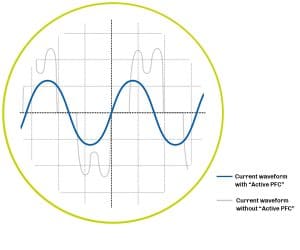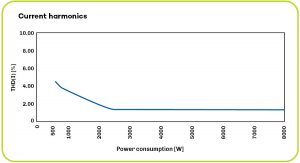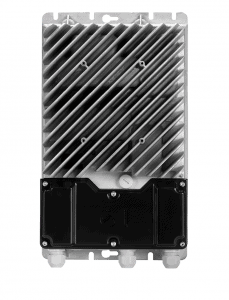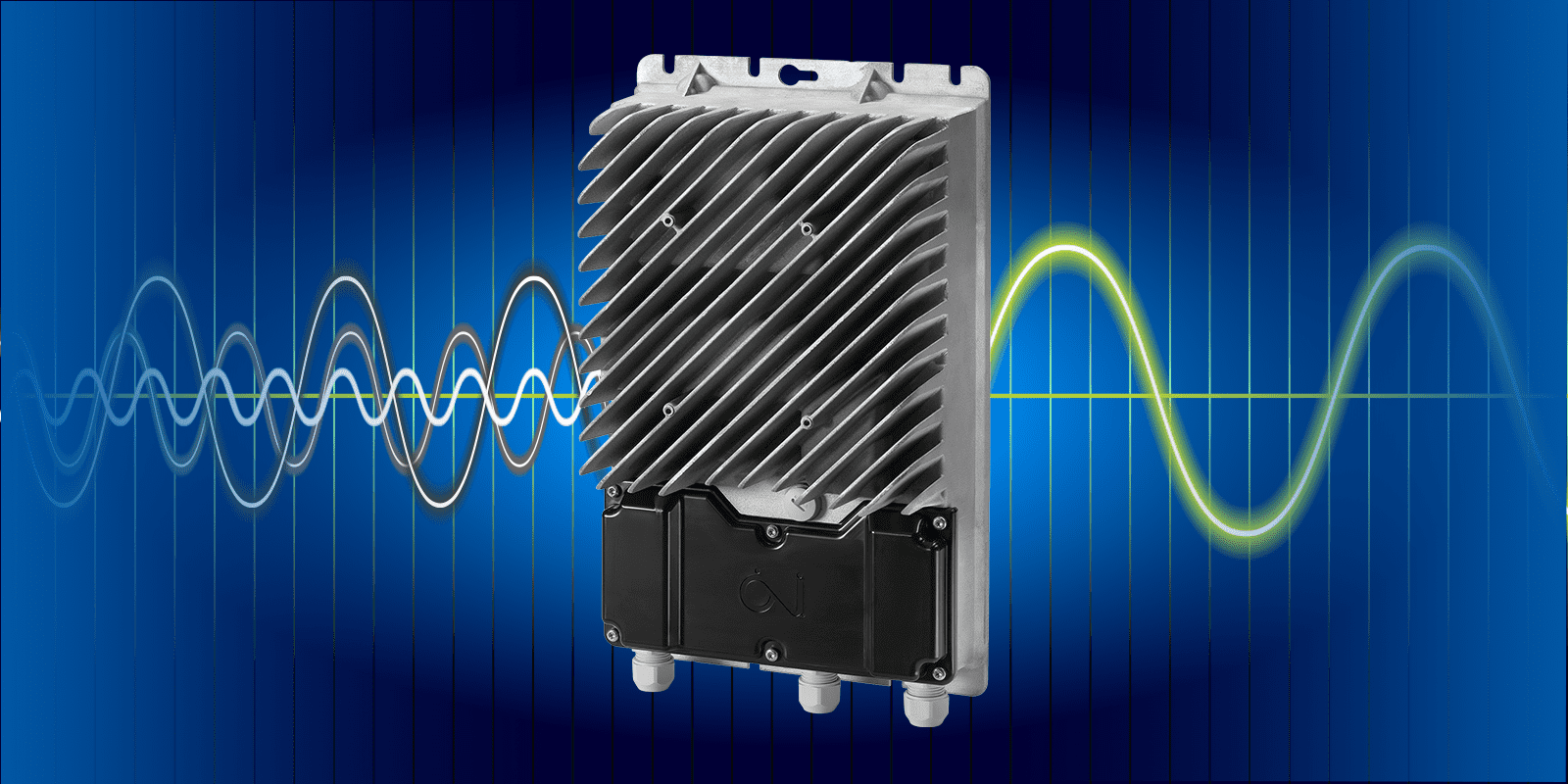Mitigating harmonics at the source
OJ Electronics’ new Ultra Low Harmonic drives have been specifically created to address a widespread and growing problem: power line harmonics and their potential harmful effect on sensitive electronic equipment. As Preben Jessen, Head of Drive products at OJ Electronics, explains: “Our new Ultra Low Harmonic Drives mitigate harmonics at the source by means of an active frontend. At the same time, the compact design is maintained as the electromagnetic components are kept small thanks to the specially developed software solution. We greatly look forward to seeing these drives in action: they’ll enable our customers to eliminate harmonic distortion in a very efficient way.”
How do harmonics arise?
 But what is the problem with harmonics, and how do they arise? Preben Jessen sums up the issue in these terms: “It’s all about non-sinusoidal current flows – which essentially means that in real life, you never get the pure sinusoidal wave form you’d see in ideal conditions. This is because so many types of equipment these days draw current in peaks, meaning that they are non-linear loads. This affects the waveform, making it more ”square”, if you like – and those waveforms contain more energy than a sine wave. The power quality changes, which is what we call power line harmonics. And those can cause all sorts of trouble, from false readings and blown fuses to real damage on sensitive equipment.” Preben hastens to add that harmonic distortion is not the same as electromagnetic interference: “Harmonic voltage/current distortion is a low frequency phenomenon, typically in the range 100 Hz to 2.0 kHz, so this is not an EMC issue. Still, harmonic distortion is certainly a problem that merits attention, and that’s why we set out to do something about it.”
But what is the problem with harmonics, and how do they arise? Preben Jessen sums up the issue in these terms: “It’s all about non-sinusoidal current flows – which essentially means that in real life, you never get the pure sinusoidal wave form you’d see in ideal conditions. This is because so many types of equipment these days draw current in peaks, meaning that they are non-linear loads. This affects the waveform, making it more ”square”, if you like – and those waveforms contain more energy than a sine wave. The power quality changes, which is what we call power line harmonics. And those can cause all sorts of trouble, from false readings and blown fuses to real damage on sensitive equipment.” Preben hastens to add that harmonic distortion is not the same as electromagnetic interference: “Harmonic voltage/current distortion is a low frequency phenomenon, typically in the range 100 Hz to 2.0 kHz, so this is not an EMC issue. Still, harmonic distortion is certainly a problem that merits attention, and that’s why we set out to do something about it.”
What’s the problem with harmonics?
 Delving deeper into the issue of drives and power line harmonics, Preben Jessen explains: “Drives are just one of the many, many types of equipment that cause this issue, but within this particular field, you’ll find that when you use a drive to control the speed of a motor to optimise energy consumption, it generates harmonics –because drives are non-linear loads. This in turn requires more energy to be transported through the system, and in commercial HVAC applications with sensitive equipment around this might lead to problems: electronic equipment can become non-reliable, you may see overheated cables, fuses, breakers and other equipment, experience nuisance trips of breakers and fuses, flickering lights, reduced system efficiency and even reduced system lifetime.”
Delving deeper into the issue of drives and power line harmonics, Preben Jessen explains: “Drives are just one of the many, many types of equipment that cause this issue, but within this particular field, you’ll find that when you use a drive to control the speed of a motor to optimise energy consumption, it generates harmonics –because drives are non-linear loads. This in turn requires more energy to be transported through the system, and in commercial HVAC applications with sensitive equipment around this might lead to problems: electronic equipment can become non-reliable, you may see overheated cables, fuses, breakers and other equipment, experience nuisance trips of breakers and fuses, flickering lights, reduced system efficiency and even reduced system lifetime.”
How OJ Electronics tackled the issue
So what did OJ Electronics do about the problem? Says Preben Jessen: “Well, we wanted to create new drive that mitigates the problems with harmonics right at the source. Essentially, we’ve incorporated an active frontend on our well-known standard drive – and this has a huge impact on harmonics. During our development process, we actually found new ways of handling harmonics by means of software that optimises component performance – basically, we make the most of what’s already there, eliminating the need for extra or outsized components – and we have applied for a patent on our distinctive approach to harmonics mitigation. One of the great benefits is that we’ve been able to keep the design very compact, so it’s still easy to adapt into existing fan types. But of course the really great thing is that these drives ensure ultra low harmonics – as little as 1.5% at full load.”
“We now offer test units to all our customers, enabling them to carry out their own qualification tests and sending fan samples with the ULH solution to their customers for approval”.
Preben Jessen, Head of Drives products at OJ Electronics
The customer’s benefits
So how will this affect customers? Says Preben Jessen: “It gives them a very simple way of handling harmonic distortion: All they need to do is to exchange the usual drive on their fan units with the ULH drive, and there you go: they now have a fan solution that complies with the strictest harmonic requirements worldwide. And they don’t need to make design changes: the new ULH unit is so compact that it can be mounted in the same location as the standard DV drive. Also, as I’ve said before, using a drive with ultra-low harmonic distortion eliminates the need for expensive external filters and other equipment. This also reduces the floor space required for technical installations.”
With all development, testing and approval procedures complete, the ULH drives are ready to go out into the world. In order to facilitate proper preparation while handling component allocation issues, OJ Electronics are now offering test samples to customers, and Preben Jessen is looking forward to seeing the ULH drives reach a wider audience: “We now offer test units to all our customers, enabling them to carry out their own qualification tests and sending fan samples with the ULH solution to their customers for approval. We have high hopes: our results have been very favourable, and we’re firmly convinced this solution is among the very best you’ll find out there. Hospitals, airports and datacentres are obvious examples of sites that will really benefit from minimising power line harmonics in this way, but with the continued rise in modern electronic equipment everywhere, we think it’s hugely relevant for all sorts of applications.”
 About the Ultra Low Harmonic Drive
About the Ultra Low Harmonic Drive
• 3-phase active PFC
• Rated power THD(i) < 1.5%
• 10-100% power THD(i) < 3%
• Power factor > 0.99
• Efficiency > 96%
• Complies with CE & UL
The Ultra Low Harmonic Drive benefits in brief
• Reduce harmonic distortion with a compact drive
• Compact, installation-friendly design
• Eliminates the need for external filters and oversized equipment
• Same mounting, installation and interface as the standard OJ DV drive
• Allows for assembled and tested harmonic-compliant fan units delivered from factory
• Ideal for data centres, hospitals, airports, ships and any other setting with sensitive equipment
For details on the NEX GEN ULH drive range, click here

